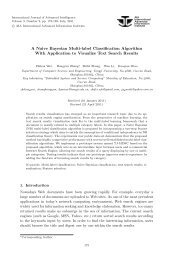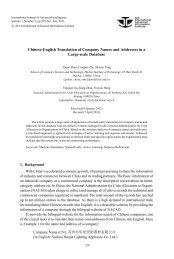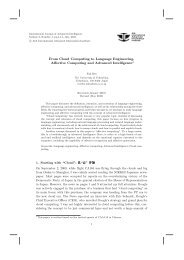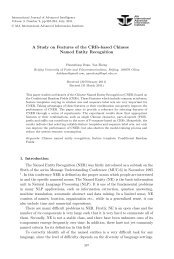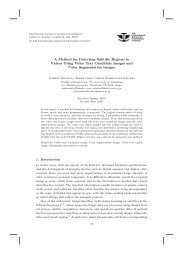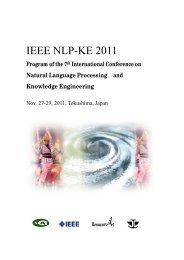Sentence Emotion Analysis and Recognition Based on Emotion ...
Sentence Emotion Analysis and Recognition Based on Emotion ...
Sentence Emotion Analysis and Recognition Based on Emotion ...
You also want an ePaper? Increase the reach of your titles
YUMPU automatically turns print PDFs into web optimized ePapers that Google loves.
Internati<strong>on</strong>al Journal of Advanced Intelligence<br />
Volume 2, Number 1, pp.105-117, July, 2010.<br />
c⃝ AIA Internati<strong>on</strong>al Advanced Informati<strong>on</strong> Institute<br />
<str<strong>on</strong>g>Sentence</str<strong>on</strong>g> <str<strong>on</strong>g>Emoti<strong>on</strong></str<strong>on</strong>g> <str<strong>on</strong>g>Analysis</str<strong>on</strong>g> <str<strong>on</strong>g>and</str<strong>on</strong>g> <str<strong>on</strong>g>Recogniti<strong>on</strong></str<strong>on</strong>g><br />
<str<strong>on</strong>g>Based</str<strong>on</strong>g> <strong>on</strong> <str<strong>on</strong>g>Emoti<strong>on</strong></str<strong>on</strong>g> Words Using Ren-CECps ∗<br />
Changqin Quan<br />
Faculty of Engineering, University of Tokushima<br />
2-1 Minamijosanjima, Tokushima 770-8506, Japan<br />
quan-c@is.tokushima-u.ac.jp<br />
Fuji Ren<br />
Faculty of Engineering, University of Tokushima<br />
2-1 Minamijosanjima, Tokushima 770-8506, Japan<br />
ren@is.tokushima-u.ac.jp<br />
Received (January 2010)<br />
Revised (May 2010)<br />
<str<strong>on</strong>g>Emoti<strong>on</strong></str<strong>on</strong>g> recogniti<strong>on</strong> <strong>on</strong> text has wide applicati<strong>on</strong>s. In this study, we make an analysis <strong>on</strong><br />
sentence emoti<strong>on</strong> based <strong>on</strong> emoti<strong>on</strong> words using Ren-CECps (a Chinese emoti<strong>on</strong> corpus).<br />
Some classificati<strong>on</strong> methods (including C4.5 decisi<strong>on</strong> tree, SVM, NaiveBayes, ZEROR,<br />
<str<strong>on</strong>g>and</str<strong>on</strong>g> Decisi<strong>on</strong>Table) have been compared. Then a supervised machine learning method<br />
(Polynomial kernel method) is proposed to recognize the eight basic emoti<strong>on</strong>s (Expect,<br />
Joy, Love, Surprise, Anxiety, Sorrow, Angry <str<strong>on</strong>g>and</str<strong>on</strong>g> Hate). Using Ren-CECps, we get the<br />
emoti<strong>on</strong> lexic<strong>on</strong>s for the eight basic emoti<strong>on</strong>s. Polynomial kernel (PK) method is used<br />
to compute the similarities between sentences <str<strong>on</strong>g>and</str<strong>on</strong>g> the eight emoti<strong>on</strong> lexic<strong>on</strong>s. Then the<br />
experiential knowledge derived from Ren-CECps is used to recognize whether the eight<br />
emoti<strong>on</strong> categories are present in a sentence. The experiments showed promising results.<br />
Keywords: <str<strong>on</strong>g>Emoti<strong>on</strong></str<strong>on</strong>g> recogniti<strong>on</strong>; Chinese emoti<strong>on</strong> corpus; Classificati<strong>on</strong> methods; Polynomial<br />
kernel.<br />
1. Introducti<strong>on</strong><br />
<str<strong>on</strong>g>Emoti<strong>on</strong></str<strong>on</strong>g>s play important role in human intelligence, rati<strong>on</strong>al decisi<strong>on</strong> making, social<br />
interacti<strong>on</strong>, percepti<strong>on</strong>, memory, learning, creativity, <str<strong>on</strong>g>and</str<strong>on</strong>g> more 1 . Given the importance<br />
of computer mediated communicati<strong>on</strong> (CMC), a lot of researches have been<br />
d<strong>on</strong>e <strong>on</strong> emoti<strong>on</strong> recogniti<strong>on</strong> 2,3 . At the same time, textual emoti<strong>on</strong> recogniti<strong>on</strong> is<br />
increasingly attracting attenti<strong>on</strong>.<br />
Previous researches for emoti<strong>on</strong>al analysis of texts have included a variety of<br />
text c<strong>on</strong>tents: weblogs 4,5 , stories 6,7 , news 8 , text messages 9 , spoken dialogs 10 , etc.<br />
For many applicati<strong>on</strong>s, identifying emoti<strong>on</strong>s <strong>on</strong>ly <strong>on</strong> document level may not be sufficient.<br />
A text-based emoti<strong>on</strong> predicti<strong>on</strong> system would benefit from identifying the<br />
∗ The prior versi<strong>on</strong> of the paper has been presented in internati<strong>on</strong>al c<strong>on</strong>ference NLP-KE 2009.<br />
105
106 Changqin Quan, Fuji Ren<br />
emoti<strong>on</strong>al affinity of sentences. The emoti<strong>on</strong> analysis <strong>on</strong> sentence level may also be<br />
important for more detailed emoti<strong>on</strong> analysis systems. Alm explored the text-based<br />
emoti<strong>on</strong> predicti<strong>on</strong> problem. In order to classify the emoti<strong>on</strong>al affinity of sentences<br />
in the narrative domain of children’s fairy tales, they annotated a corpus of 22<br />
Grimms’ tales <strong>on</strong> sentence level with eight emoti<strong>on</strong> categories (Angry, disgusted,<br />
fearful, happy, sad, positively Surprised, negatively Surprised) 7 . Neviarouskaya addresseds<br />
the tasks of recogniti<strong>on</strong> <str<strong>on</strong>g>and</str<strong>on</strong>g> interpretati<strong>on</strong> of affect communicated through<br />
text messaging 9 . Aman <str<strong>on</strong>g>and</str<strong>on</strong>g> Szpakowicz classify emoti<strong>on</strong>al <str<strong>on</strong>g>and</str<strong>on</strong>g> n<strong>on</strong>-emoti<strong>on</strong>al sentences<br />
based <strong>on</strong> a knowledge-based approach 11 . Classifying the mood of a single<br />
text is a hard task; state-of-the-art methods in text classificati<strong>on</strong> achieve <strong>on</strong>ly modest<br />
performance in this domain 4 . In this area, some of the hardest problems involve<br />
acquiring large corpora tagged with detail linguistic expressi<strong>on</strong>s that indicate emoti<strong>on</strong>.<br />
In this study, we make an analysis <strong>on</strong> sentence emoti<strong>on</strong> based <strong>on</strong> emoti<strong>on</strong> words<br />
using Ren-CECps a (a Chinese emoti<strong>on</strong> corpus developed by Ren-lab) 12 . Some classificati<strong>on</strong><br />
methods (including C4.5 decisi<strong>on</strong> tree, SVM, NaiveBayes, ZEROR, <str<strong>on</strong>g>and</str<strong>on</strong>g><br />
Decisi<strong>on</strong>Table) have been compared. Then a supervised machine learning method<br />
(Polynomial kernel method) is proposed to recognize the eight basic emoti<strong>on</strong>s (Expect,<br />
Joy, Love, Surprise, Anxiety, Sorrow, Angry <str<strong>on</strong>g>and</str<strong>on</strong>g> Hate). Using Ren-CECps,<br />
we get the emoti<strong>on</strong> lexic<strong>on</strong>s for the eight basic emoti<strong>on</strong>s. Statistics show that the<br />
emoti<strong>on</strong> lexic<strong>on</strong>s derived from Ren-CECps are used more often in real use of language<br />
for emoti<strong>on</strong>al expressi<strong>on</strong>s than HOWNET sentimental lexic<strong>on</strong>s. Polynomial<br />
kernel (PK) method is used to compute the similarities between sentences <str<strong>on</strong>g>and</str<strong>on</strong>g> the<br />
eight emoti<strong>on</strong> lexic<strong>on</strong>s. Then the experiential knowledge derived from Ren-CECps<br />
is used to recognize whether the eight emoti<strong>on</strong> categories are present in a sentence.<br />
The experiments showed promising results compared with the above classificati<strong>on</strong><br />
methods.<br />
The remainder of this paper is organized as follows. Secti<strong>on</strong> 2 describes the<br />
c<strong>on</strong>structi<strong>on</strong> of Ren-CECps. Secti<strong>on</strong> 3 presents the comparis<strong>on</strong> of some classificati<strong>on</strong><br />
methods (including C4.5 decisi<strong>on</strong> tree, SVM, NaiveBayes, ZEROR, <str<strong>on</strong>g>and</str<strong>on</strong>g> Decisi<strong>on</strong>Table)<br />
for sentence emoti<strong>on</strong> recogniti<strong>on</strong> based <strong>on</strong> emoti<strong>on</strong> words. In secti<strong>on</strong> 4,<br />
Polynomial kernel method for sentence emoti<strong>on</strong> recogniti<strong>on</strong> <str<strong>on</strong>g>and</str<strong>on</strong>g> experimental results<br />
are described. Secti<strong>on</strong> 5 c<strong>on</strong>cludes this study with closing remarks <str<strong>on</strong>g>and</str<strong>on</strong>g> future<br />
directi<strong>on</strong>s.<br />
2. Introducti<strong>on</strong> of Ren-CECps<br />
With the increase in the number of people with access to the internet, <str<strong>on</strong>g>and</str<strong>on</strong>g> the<br />
availability of tools for easily creating a weblog, there has been a great increase in<br />
the number of weblogs. Weblogs are often touted as the new journalism. Writing<br />
suits the recording of facts <str<strong>on</strong>g>and</str<strong>on</strong>g> the communicati<strong>on</strong> of ideas, <str<strong>on</strong>g>and</str<strong>on</strong>g> their textual basis<br />
a http://a1-www.is.tokushima-u.ac.jp/member/ren/Ren-CECps1.0/Ren-CECps1.0.html
<str<strong>on</strong>g>Sentence</str<strong>on</strong>g> <str<strong>on</strong>g>Emoti<strong>on</strong></str<strong>on</strong>g> <str<strong>on</strong>g>Analysis</str<strong>on</strong>g> <str<strong>on</strong>g>and</str<strong>on</strong>g> <str<strong>on</strong>g>Recogniti<strong>on</strong></str<strong>on</strong>g> <str<strong>on</strong>g>Based</str<strong>on</strong>g> <strong>on</strong> <str<strong>on</strong>g>Emoti<strong>on</strong></str<strong>on</strong>g> Words Using Ren-CECps 107<br />
makes them equally suitable for recording emoti<strong>on</strong>s <str<strong>on</strong>g>and</str<strong>on</strong>g> opini<strong>on</strong>s. Blogs are selected<br />
as data source for Ren-CECps annotati<strong>on</strong>.<br />
Ren-CECps is c<strong>on</strong>structed based <strong>on</strong> a relative fine-grained annotati<strong>on</strong> scheme,<br />
annotating emoti<strong>on</strong> in text at three levels: document, paragraph, <str<strong>on</strong>g>and</str<strong>on</strong>g> sentence.<br />
<str<strong>on</strong>g>Sentence</str<strong>on</strong>g> level is the basic level for emoti<strong>on</strong> annotati<strong>on</strong>, the annotati<strong>on</strong> include<br />
intensities of the eight basic emoti<strong>on</strong> classes, emoti<strong>on</strong> holder/target, emoti<strong>on</strong>al keywords/phrases,<br />
rhetoric, emoti<strong>on</strong>al punctuati<strong>on</strong>, emoti<strong>on</strong>al objective/subjective <str<strong>on</strong>g>and</str<strong>on</strong>g><br />
emoti<strong>on</strong>al polarity.<br />
Paragraph level is the upper level of sentence level, the annotati<strong>on</strong> include intensities<br />
of the eight basic emoti<strong>on</strong> classes, topic keywords to reflect the topic of a<br />
paragraph, <str<strong>on</strong>g>and</str<strong>on</strong>g> the numbers of topic sentences that can express the main points of<br />
this paragraph. Document level is the uppermost level in annotati<strong>on</strong>; its annotati<strong>on</strong><br />
is similar to paragraph level. The tokenised text files are organized into XML<br />
documents, with Chinese segmentati<strong>on</strong> tags <str<strong>on</strong>g>and</str<strong>on</strong>g> part-of-speech tags included as<br />
attributes of the tokens. An example document is listed in Fig. 1.<br />
The main purpose of c<strong>on</strong>structing this emoti<strong>on</strong> corpus is to support the development<br />
<str<strong>on</strong>g>and</str<strong>on</strong>g> evaluati<strong>on</strong> of emoti<strong>on</strong> analysis systems in Chinese. The all dataset<br />
c<strong>on</strong>sisted of 1,487 blog articles published at sina blog, sciencenet blog, baidu blog,<br />
qz<strong>on</strong>e blog, qq blog, <str<strong>on</strong>g>and</str<strong>on</strong>g> other blog websites. There are 11,255 paragraphs, 35,096<br />
sentences, <str<strong>on</strong>g>and</str<strong>on</strong>g> 878,164 Chinese words c<strong>on</strong>tained in this corpus.<br />
3. <str<strong>on</strong>g>Sentence</str<strong>on</strong>g> <str<strong>on</strong>g>Emoti<strong>on</strong></str<strong>on</strong>g> <str<strong>on</strong>g>Analysis</str<strong>on</strong>g> <str<strong>on</strong>g>Based</str<strong>on</strong>g> <strong>on</strong> <str<strong>on</strong>g>Emoti<strong>on</strong></str<strong>on</strong>g> Words<br />
<str<strong>on</strong>g>Sentence</str<strong>on</strong>g>s are the basic units for emoti<strong>on</strong>al expressi<strong>on</strong>. Previous work have included<br />
various approaches for sentence level emoti<strong>on</strong> detecti<strong>on</strong>. According to the cues for<br />
emoti<strong>on</strong> expressi<strong>on</strong>, there are two main methods for sentence emoti<strong>on</strong> recogniti<strong>on</strong>:<br />
emoti<strong>on</strong> provoking event based method <str<strong>on</strong>g>and</str<strong>on</strong>g> emoti<strong>on</strong> words based method. Regarding<br />
the emoti<strong>on</strong> words based method, which is seen as the most naive approach <str<strong>on</strong>g>and</str<strong>on</strong>g><br />
probably also the most popular method.<br />
The emoti<strong>on</strong>s of a sentence can be affected by many factors: emoti<strong>on</strong> words,<br />
negative words, c<strong>on</strong>juncti<strong>on</strong>s, puntuati<strong>on</strong>s, c<strong>on</strong>texts, <str<strong>on</strong>g>and</str<strong>on</strong>g> so <strong>on</strong>. To explore the role<br />
of emoti<strong>on</strong> words for sentence emoti<strong>on</strong> recogniti<strong>on</strong>, we compare five classic classificati<strong>on</strong><br />
methods (including C4.5 decisi<strong>on</strong> tree, SVM, NaiveBayes, ZEROR, <str<strong>on</strong>g>and</str<strong>on</strong>g><br />
Decisi<strong>on</strong>Table) for sentence emoti<strong>on</strong> recogniti<strong>on</strong> based <strong>on</strong> emoti<strong>on</strong> words.<br />
We select training corpus from Ren-CECps r<str<strong>on</strong>g>and</str<strong>on</strong>g>omly. Training corpus includes<br />
100 documents (c<strong>on</strong>taining 2,863 sentences). As sentence emoti<strong>on</strong> is subjective entity,<br />
a sentence may evoke multiple emoti<strong>on</strong>s in different people’s mind. A part of<br />
documents in Ren-CECps have been annotated by three annotators independently<br />
to measure agreement <strong>on</strong> the annotati<strong>on</strong> of this corpus, which include 26 documents<br />
with a total of 805 sentences, 19,738 words. We select testing corpus from<br />
this part of corpus r<str<strong>on</strong>g>and</str<strong>on</strong>g>omly. Testing corpus includes 10 documents (c<strong>on</strong>taining 387<br />
sentences). An output of word emoti<strong>on</strong>(s) will be regarded as a correct result if it<br />
is in agreement with any <strong>on</strong>e item of word emoti<strong>on</strong>(s) provided by the three anno-
108 Changqin Quan, Fuji Ren<br />
Fig. 1. An annotated document in XML format.
<str<strong>on</strong>g>Sentence</str<strong>on</strong>g> <str<strong>on</strong>g>Emoti<strong>on</strong></str<strong>on</strong>g> <str<strong>on</strong>g>Analysis</str<strong>on</strong>g> <str<strong>on</strong>g>and</str<strong>on</strong>g> <str<strong>on</strong>g>Recogniti<strong>on</strong></str<strong>on</strong>g> <str<strong>on</strong>g>Based</str<strong>on</strong>g> <strong>on</strong> <str<strong>on</strong>g>Emoti<strong>on</strong></str<strong>on</strong>g> Words Using Ren-CECps 109<br />
tators. The accuracies are measured by F-value. The results of F-value include: (a)<br />
recognize emoti<strong>on</strong> <str<strong>on</strong>g>and</str<strong>on</strong>g> unemoti<strong>on</strong> sentences; (b) recognize the eight basic emoti<strong>on</strong>s<br />
for emoti<strong>on</strong> sentences (complete matching); (c) recognize the eight basic emoti<strong>on</strong>s<br />
for emoti<strong>on</strong> sentences (single emoti<strong>on</strong> matching).<br />
Table 1 gives the results of F-value for different classificati<strong>on</strong> methods for sentence<br />
emoti<strong>on</strong> recogniti<strong>on</strong> based <strong>on</strong> emoti<strong>on</strong> words.<br />
Table 1. F-value for different classificati<strong>on</strong> methods for sentence emoti<strong>on</strong> recogniti<strong>on</strong> based <strong>on</strong><br />
emoti<strong>on</strong> words.<br />
(a) recognize emoti<strong>on</strong> or unemoti<strong>on</strong> sentences<br />
(b) recognize the eight basic emoti<strong>on</strong>s for emoti<strong>on</strong> sentences (complete matching)<br />
(c) recognize the eight basic emoti<strong>on</strong>s for emoti<strong>on</strong> sentences (single emoti<strong>on</strong><br />
matching)<br />
Classificati<strong>on</strong><br />
F-value<br />
method (a) (b) (c)<br />
C4.5 decisi<strong>on</strong> tree 86.0 53.9 71.0<br />
SVM 98.0 84.5 95.7<br />
NaiveBayes 94.7 41.0 67.9<br />
ZEROR 94.7 23.1 40.7<br />
Decisi<strong>on</strong>Table 94.7 23.1 40.7<br />
As shown in Table 1, SVM showed the best classificati<strong>on</strong> results compared with<br />
other classificati<strong>on</strong> methods. We can find that the above classic classificati<strong>on</strong> methods<br />
are not satisfying for sentence emoti<strong>on</strong> recogniti<strong>on</strong> when <strong>on</strong>ly use emoti<strong>on</strong> word<br />
as feature.<br />
4. Polynomial Kernel Method for <str<strong>on</strong>g>Sentence</str<strong>on</strong>g> <str<strong>on</strong>g>Emoti<strong>on</strong></str<strong>on</strong>g> <str<strong>on</strong>g>Recogniti<strong>on</strong></str<strong>on</strong>g><br />
Kernel methods (KMs) have been well used for solving machine learning problems.<br />
KMs make use of the informati<strong>on</strong> encoded in the inner-product am<strong>on</strong>g all pairs of<br />
data items, avoiding explicitly to compute the feature vector for a given input. In<br />
this study, we explore polynomial kernel (PK) method for the problem of emoti<strong>on</strong><br />
recogniti<strong>on</strong>.<br />
<str<strong>on</strong>g>Based</str<strong>on</strong>g> <strong>on</strong> Ren-CECps, we first use Polynomial kernel (PK) method to compute<br />
the similarities between sentences <str<strong>on</strong>g>and</str<strong>on</strong>g> emoti<strong>on</strong> lexic<strong>on</strong>s. Then the experiential<br />
knowledge derived from Ren-CECps is used to recognize whether the eight emoti<strong>on</strong><br />
categories (Expect, Joy, Love, Surprise, Anxiety, Sorrow, Angry <str<strong>on</strong>g>and</str<strong>on</strong>g> Hate) are<br />
present in a sentence.
110 Changqin Quan, Fuji Ren<br />
4.1. Polynomial kernel method<br />
KMs approach the problem by mapping the data into a high dimensi<strong>on</strong>al feature<br />
space, <str<strong>on</strong>g>and</str<strong>on</strong>g> a variety of methods can be used to find relati<strong>on</strong>s in the data in that<br />
space 13 . In the vector-space model, documents are represented by a matrix D, whose<br />
columns are the documents <str<strong>on</strong>g>and</str<strong>on</strong>g> rows are the terms. The corresp<strong>on</strong>ding kernel is<br />
given by the inner product between the feature vectors 14 , see Eq. (1) <str<strong>on</strong>g>and</str<strong>on</strong>g> Eq. (2).<br />
K = D ′ D (1)<br />
N∑<br />
K(d 1 , d 2 ) =< φ(d 1 ), φ(d 2 ) >= tf(t j , d 1 )tf(t j , d 2 ) (2)<br />
j=1<br />
Document d is represented by a row vector, see Eq. (3) .<br />
φ(d) = (tf(t 1 , d), ..., tf(t j , d), ..., tf(t N , d), ) ∈ R N (3)<br />
Where tf(t j , d) is the frequency of term i appeared in document j.<br />
A linear transformati<strong>on</strong> is φ(d) = φ(d)×S, where S is any appropriately shaped<br />
matrix, can be set by Eq. (4).<br />
S = RP (4)<br />
Where R is a term-weight matrix, <str<strong>on</strong>g>and</str<strong>on</strong>g> is diag<strong>on</strong>al, whose entire R(i, i) are the<br />
weight of the term i, can be defined by the inverse document frequency idf(t) =<br />
l<br />
ln(<br />
df(t)<br />
), l is the total number of documents in the corpus, df(t) is the number of<br />
documents that c<strong>on</strong>tain the given term. P is a term-document matrix, whose entire<br />
P (i, j) are the emoti<strong>on</strong> weight of the term i in document j. (The method of getting<br />
matrix P is described in 4.2)<br />
The new kernel K for this feature space is defined by Eq. (5) .<br />
K = D ′ D = (DS) ′ DS = (DRP ) ′ DRP (5)<br />
For a given kernel K(d 1 , d 2 ), the derived polynomial kernel is defined by Eq. (6).<br />
K(d 1 , d 2 ) = (K(d 1 , d 2 ) + c) d (6)<br />
Fig. 2 shows the architectural overview of getting polynomial kernel (PK).<br />
The text preprocessing <str<strong>on</strong>g>and</str<strong>on</strong>g> feature extracti<strong>on</strong> process is Chinese word segmentati<strong>on</strong><br />
<str<strong>on</strong>g>and</str<strong>on</strong>g> stop words filtrati<strong>on</strong>. By vector space model (based <strong>on</strong> tf.idf computing),<br />
we can get the Term-Doc matrix <str<strong>on</strong>g>and</str<strong>on</strong>g> Tf.idf matrix. And then, we can get the eight<br />
emoti<strong>on</strong> lexic<strong>on</strong>s from the train corpus. With the emoti<strong>on</strong>al word intensity values<br />
<str<strong>on</strong>g>and</str<strong>on</strong>g> Term-Doc Matrix, we can get the emoti<strong>on</strong> weight matrix. By kernel computing<br />
(Eq. (6)), the polynomial kernel (PK) is obtained.
<str<strong>on</strong>g>Sentence</str<strong>on</strong>g> <str<strong>on</strong>g>Emoti<strong>on</strong></str<strong>on</strong>g> <str<strong>on</strong>g>Analysis</str<strong>on</strong>g> <str<strong>on</strong>g>and</str<strong>on</strong>g> <str<strong>on</strong>g>Recogniti<strong>on</strong></str<strong>on</strong>g> <str<strong>on</strong>g>Based</str<strong>on</strong>g> <strong>on</strong> <str<strong>on</strong>g>Emoti<strong>on</strong></str<strong>on</strong>g> Words Using Ren-CECps 111<br />
Fig. 2. The architectural overview of getting PK matrix.<br />
4.2. <str<strong>on</strong>g>Emoti<strong>on</strong></str<strong>on</strong>g>al words annotati<strong>on</strong> in Ren-CECps <str<strong>on</strong>g>and</str<strong>on</strong>g> emoti<strong>on</strong><br />
weight of terms<br />
In the annotati<strong>on</strong> scheme of Ren-CECps, direct affective words <str<strong>on</strong>g>and</str<strong>on</strong>g> indirect affective<br />
words in a sentence are all annotated. Some emoti<strong>on</strong>al keywords may not bear<br />
emoti<strong>on</strong>s by themselves, but in a given c<strong>on</strong>text, they express emoti<strong>on</strong>s, <str<strong>on</strong>g>and</str<strong>on</strong>g> in<br />
similar c<strong>on</strong>texts, they may express similar emoti<strong>on</strong>s.<br />
An emoti<strong>on</strong>al keyword or phrase is represented as a vector to record its intensities<br />
of the eight basic emoti<strong>on</strong>al classes (Expect, Joy, Love, Surprise, Anxiety,<br />
Sorrow, Angry <str<strong>on</strong>g>and</str<strong>on</strong>g> Hate). For instance, the vector for the word “ 喜 欢 (like)”<br />
−→ w = (0.0, 0.3, 0.9, 0.0, 0.0, 0.0, 0.0, 0.0) indicates the emoti<strong>on</strong>s of weak Joy <str<strong>on</strong>g>and</str<strong>on</strong>g><br />
str<strong>on</strong>g Love; “ 春 天 (English: spring)” −→ w = (0.1, 0.3, 0.3, 0.0, 0.0, 0.0, 0.0, 0.0) indicates<br />
the emoti<strong>on</strong>s of weak Expect, Joy <str<strong>on</strong>g>and</str<strong>on</strong>g> Love. (The emoti<strong>on</strong> classes <str<strong>on</strong>g>and</str<strong>on</strong>g> intensity<br />
values may be different because of different annotators). <str<strong>on</strong>g>Emoti<strong>on</strong></str<strong>on</strong>g> annotati<strong>on</strong> is<br />
a hard task because the nature of emoti<strong>on</strong> is inherently ambiguous (both in terms<br />
of the emoti<strong>on</strong> classes <str<strong>on</strong>g>and</str<strong>on</strong>g> the natural language words that represent them). In the<br />
process of annotati<strong>on</strong>, annotators were encouraged to follow their “first intuiti<strong>on</strong>”.<br />
<str<strong>on</strong>g>Based</str<strong>on</strong>g> <strong>on</strong> this corpus, we can get the emoti<strong>on</strong> lexic<strong>on</strong>s for the eight basic emoti<strong>on</strong>s.<br />
Table 2 is a comparis<strong>on</strong> between the emoti<strong>on</strong> lexic<strong>on</strong>s derived from Ren-<br />
CECps (1487 articles) <str<strong>on</strong>g>and</str<strong>on</strong>g> the Chinese sentimental lexic<strong>on</strong>s published by HOWNET<br />
(beta versi<strong>on</strong>) 15 .
112 Changqin Quan, Fuji Ren<br />
Table 2. <str<strong>on</strong>g>Emoti<strong>on</strong></str<strong>on</strong>g> lexic<strong>on</strong>s comparis<strong>on</strong> between Ren-CECps <str<strong>on</strong>g>and</str<strong>on</strong>g> HOWNET.<br />
Statistics Ren-CECps HOWNET<br />
Word num. 19,062 8,936<br />
Word num. not appear<br />
in the opp<strong>on</strong>ent list<br />
5,681 15,909<br />
Total word num. that appear<br />
in the 1,487 articles<br />
228,455 125,268<br />
word num.(%) that the occurrence<br />
in the 1,487 articles below 2<br />
13,006<br />
(68.2%)<br />
6,916<br />
(77.4%)<br />
word num.(%) that the occurrence<br />
in the 1487 articles from 2 to 5<br />
2,556<br />
((13.4%))<br />
722<br />
(8.1%)<br />
word num.(%) that the occurrence<br />
in the 1,487 articles above 5<br />
3,500<br />
(18.4%)<br />
1704<br />
(14.5%)<br />
To the best of our knowledge, at present, there are no relatively large Chinese<br />
emoti<strong>on</strong> lexic<strong>on</strong>s. HOWNET sentimental lexic<strong>on</strong>s are the <strong>on</strong>ly resources published<br />
for Chinese sentiment analysis. As shown in Table 2, the emoti<strong>on</strong> lexic<strong>on</strong>s derived<br />
from Ren-CECps are used more often in real use of language for emoti<strong>on</strong>al expressi<strong>on</strong>s<br />
than HOWNET sentimental lexic<strong>on</strong>s. In HOWNET sentimental lexic<strong>on</strong>s,<br />
77.4% words of them <strong>on</strong>ly occur 0 or 1 time in this corpus; in Ren-CECps emoti<strong>on</strong><br />
lexic<strong>on</strong>, 31.8% words occur more than or equal 2 times. In the annotati<strong>on</strong> scheme<br />
of Ren-CECps, the same word may be annotated with different emoti<strong>on</strong>s in different<br />
c<strong>on</strong>texts, <str<strong>on</strong>g>and</str<strong>on</strong>g> the emoti<strong>on</strong> intensity values may be different. For the eight<br />
basic emoti<strong>on</strong>s, their emoti<strong>on</strong> lexic<strong>on</strong>s include those words annotated with n<strong>on</strong>-zero<br />
intensity value of the corresp<strong>on</strong>ding emoti<strong>on</strong>s. And the emoti<strong>on</strong> intensity value for<br />
each word is the average value of the values in multiple annotati<strong>on</strong>s for the word.<br />
Then, we can get the matrix P (in secti<strong>on</strong> 4.1), whose entire P (i, j) are the emoti<strong>on</strong><br />
weight of the term i in document j.<br />
4.3. Experiential Knowledge for <str<strong>on</strong>g>Emoti<strong>on</strong></str<strong>on</strong>g> Class Judgments<br />
Through statistical analysis, much experiential knowledge can be derived from Ren-<br />
CECps. We use the experiential knowledge of emoti<strong>on</strong> number in each sentence to<br />
judge if a sentence c<strong>on</strong>tains some emoti<strong>on</strong>s. Table 3 shows the sentence numbers<br />
(percentage) c<strong>on</strong>taining emoti<strong>on</strong> number from 0 to 8.<br />
As can be seen from table 3, most sentences c<strong>on</strong>tain <strong>on</strong>e or two emoti<strong>on</strong>s, few<br />
sentences c<strong>on</strong>tain more than four emoti<strong>on</strong>s. We also get the average value of emoti<strong>on</strong><br />
number for each sentence, which is 1.36. <str<strong>on</strong>g>Based</str<strong>on</strong>g> <strong>on</strong> this result, we can judge whether<br />
some emoti<strong>on</strong>s are present in a sentence.<br />
Let sim(s i , l j ) is the similarity between sentence i <str<strong>on</strong>g>and</str<strong>on</strong>g> lexic<strong>on</strong> j computed by<br />
polynomial kernel (PK) method, <str<strong>on</strong>g>and</str<strong>on</strong>g> then we can get the similarity array from the
<str<strong>on</strong>g>Sentence</str<strong>on</strong>g> <str<strong>on</strong>g>Emoti<strong>on</strong></str<strong>on</strong>g> <str<strong>on</strong>g>Analysis</str<strong>on</strong>g> <str<strong>on</strong>g>and</str<strong>on</strong>g> <str<strong>on</strong>g>Recogniti<strong>on</strong></str<strong>on</strong>g> <str<strong>on</strong>g>Based</str<strong>on</strong>g> <strong>on</strong> <str<strong>on</strong>g>Emoti<strong>on</strong></str<strong>on</strong>g> Words Using Ren-CECps 113<br />
Table 3. <str<strong>on</strong>g>Sentence</str<strong>on</strong>g> numbers (percentage) c<strong>on</strong>taining emoti<strong>on</strong> number from 0 to 8.<br />
<str<strong>on</strong>g>Emoti<strong>on</strong></str<strong>on</strong>g> num. 0 1 2 3 4 5 6 7 8<br />
<str<strong>on</strong>g>Sentence</str<strong>on</strong>g> num. 2,806 18,959 11,331 1,809 169 16 6 0 0<br />
(%)<br />
(8.0) (54.0) (32.3) (5.2) (0.5) (0.0) (0.0) (0.0) (0.0)<br />
maximum down to the minimum, see Eq. (7).<br />
{sim(s i , l 1 ), sim(s i , l 2 ), ..., sim(s i , l 8 ))} (7)<br />
The emoti<strong>on</strong>s of sentence i are judged by Eq. (8).<br />
⎧<br />
e(l 1 ), if sim(s i , l 1 ) − sim(s i , l 2 ) > α<br />
{e(l 1 ), e(l 2 )}, if sim(s i , l 1 ) − sim(s i , l 2 ) ≤ α<br />
<str<strong>on</strong>g>and</str<strong>on</strong>g> sim(s i , l 2 ) − sim(s i , l 2 ) > β<br />
⎪⎨ {e(l 1 ), e(l 2 ), e(l 3 )}, if sim(s i , l 1 ) − sim(s i , l 2 ) ≤ α<br />
<str<strong>on</strong>g>Emoti<strong>on</strong></str<strong>on</strong>g>(sentence i ) =<br />
<str<strong>on</strong>g>and</str<strong>on</strong>g> sim(s i , l 2 ) − sim(s i , l 3 ) ≤ β<br />
<str<strong>on</strong>g>and</str<strong>on</strong>g> sim(s i , l 4 ) − sim(s i , l 4 ) > γ<br />
{null}, if sim(s i , l 1 ) − sim(s i , l 2 ) ≤ α<br />
<str<strong>on</strong>g>and</str<strong>on</strong>g> sim(s ⎪⎩<br />
i , l 2 ) − sim(s i , l 3 ) ≤ β<br />
<str<strong>on</strong>g>and</str<strong>on</strong>g> sim(s i , l 4 ) − sim(s i , l 4 ) ≤ γ<br />
(8)<br />
in which, e(l i ) is the emoti<strong>on</strong> of lexic<strong>on</strong> i , α, β, γ are threshold values to c<strong>on</strong>trol<br />
the emoti<strong>on</strong> number of a sentence.<br />
4.4. Experiments <str<strong>on</strong>g>and</str<strong>on</strong>g> results<br />
Ren-CECps (including 1487 articles) is used for the experiment, in which, 75%<br />
documents are used as training set, including 1115 documents (25,849 sentences)<br />
<str<strong>on</strong>g>and</str<strong>on</strong>g> the other 25% are used as test set, including 372 documents (9,247 sentences) .<br />
Table 4 shows the numbers of the eight emoti<strong>on</strong> lexic<strong>on</strong>s derived from Ren-CECps.<br />
Table 4. Numbers of the eight emoti<strong>on</strong> lexic<strong>on</strong>s.<br />
Expect Joy Love Surprise Anxiety Sorrow Angry Hate<br />
Word num. 2,511 4,612 8,222 671 5,378 3,620 1,644 4,191<br />
S1-S4 are examples of sentences <str<strong>on</strong>g>and</str<strong>on</strong>g> the emoti<strong>on</strong>s annotated by annotators.<br />
S1): 我 马 上 感 觉 到 了 她 对 女 儿 的 思 念 之 情 。
114 Changqin Quan, Fuji Ren<br />
English: I felt her str<strong>on</strong>g yearnings toward her daughter right away.<br />
<str<strong>on</strong>g>Emoti<strong>on</strong></str<strong>on</strong>g> (S1) = Love;<br />
S2): 有 多 少 人 是 快 乐 的 呢 <br />
English: How many people are happy<br />
<str<strong>on</strong>g>Emoti<strong>on</strong></str<strong>on</strong>g> (S2) = Anxiety, Sorrow;<br />
S3): 她 在 同 学 中 特 别 受 欢 迎 。<br />
English: She is greatly welcomed in her classmates.<br />
<str<strong>on</strong>g>Emoti<strong>on</strong></str<strong>on</strong>g> (S3) = Love, Joy;<br />
S4): 这 么 美 好 的 春 光 应 该 给 人 们 带 来 温 暖 和 欣 慰 , 可 是 我 的 内 心 却 冷 冷 作 痛 ,<br />
这 是 为 什 么 呢 <br />
English: Such pleasant spring sunshine should bring people with warm <str<strong>on</strong>g>and</str<strong>on</strong>g> gratefulness,<br />
but I felt heartburn, why<br />
<str<strong>on</strong>g>Emoti<strong>on</strong></str<strong>on</strong>g> (S4) = Anxiety, Sorrow;<br />
Table 5 shows examples of similarities between the eight emoti<strong>on</strong> lexic<strong>on</strong>s <str<strong>on</strong>g>and</str<strong>on</strong>g><br />
sentences computed by polynomial kernel (PK) method. (The values of similarity<br />
are normalized.)<br />
Table 5. Similarities between the eight emoti<strong>on</strong> lexic<strong>on</strong>s <str<strong>on</strong>g>and</str<strong>on</strong>g> sentences computed by PK method.<br />
<str<strong>on</strong>g>Sentence</str<strong>on</strong>g>s S1 S2 S3 S4<br />
Expect 0.13 0.10 0.11 0.11<br />
Joy 0.16 0.13 0.19 0.16<br />
Love 0.23 0.16 0.24 0.21<br />
Surprise 0.05 0.05 0.05 0.05<br />
Anxiety 0.16 0.18 0.13 0.14<br />
Sorrow 0.12 0.13 0.09 0.11<br />
Angry 0.06 0.09 0.07 0.08<br />
Hate 0.09 0.13 0.11 0.12<br />
In Eq. (8), when we set the threshold values α = 0.05, β = 0.03, γ = 0.01, we<br />
get the emoti<strong>on</strong>s for sentence S1-S4:<br />
<str<strong>on</strong>g>Emoti<strong>on</strong></str<strong>on</strong>g> (S1) = Love;<br />
<str<strong>on</strong>g>Emoti<strong>on</strong></str<strong>on</strong>g> (S2) = Anxiety, Love, Sorrow;<br />
<str<strong>on</strong>g>Emoti<strong>on</strong></str<strong>on</strong>g> (S3) = Love, Joy;<br />
<str<strong>on</strong>g>Emoti<strong>on</strong></str<strong>on</strong>g> (S4) = Love, Joy, Anxiety;<br />
From the above results, we can find that, the emoti<strong>on</strong>s computed by our method<br />
for S1 <str<strong>on</strong>g>and</str<strong>on</strong>g> S3 are in agreement with the emoti<strong>on</strong> annotated by annotators. In S2,<br />
besides the two correct emoti<strong>on</strong>s of Anxiety <str<strong>on</strong>g>and</str<strong>on</strong>g> Sorrow, we get an error emoti<strong>on</strong><br />
of Love. In S4, we get two error emoti<strong>on</strong>s of Love <str<strong>on</strong>g>and</str<strong>on</strong>g> Joy.<br />
C<strong>on</strong>ducting a simple error analysis, we find that there is a word “ 快 乐 (happy)”<br />
in S2, which can express the emoti<strong>on</strong> of Love; <str<strong>on</strong>g>and</str<strong>on</strong>g> there are more positive words in<br />
S4 such as “ 美 好 (pleasant)”, “ 温 暖 (warm)”, “ 欣 慰 (gratefulness)” cause the emoti<strong>on</strong>
<str<strong>on</strong>g>Sentence</str<strong>on</strong>g> <str<strong>on</strong>g>Emoti<strong>on</strong></str<strong>on</strong>g> <str<strong>on</strong>g>Analysis</str<strong>on</strong>g> <str<strong>on</strong>g>and</str<strong>on</strong>g> <str<strong>on</strong>g>Recogniti<strong>on</strong></str<strong>on</strong>g> <str<strong>on</strong>g>Based</str<strong>on</strong>g> <strong>on</strong> <str<strong>on</strong>g>Emoti<strong>on</strong></str<strong>on</strong>g> Words Using Ren-CECps 115<br />
of this sentence positive, , but more linguistic expressi<strong>on</strong>s are ignored, such as the<br />
c<strong>on</strong>juncti<strong>on</strong> “ 可 是 (but)” <str<strong>on</strong>g>and</str<strong>on</strong>g> rhetorical questi<strong>on</strong>.<br />
F-value is used to evaluate this method. Our method obtained 65.0% F-value<br />
for recognize emoti<strong>on</strong> or unemoti<strong>on</strong> sentences, 46.7% F-value for recognize the eight<br />
basic emoti<strong>on</strong>s for emoti<strong>on</strong> sentences (complete matching), <str<strong>on</strong>g>and</str<strong>on</strong>g> 70.1% F-value for<br />
recognize the eight basic emoti<strong>on</strong>s for emoti<strong>on</strong> sentences (single emoti<strong>on</strong> matching).<br />
When we use the same experimental setup as that have been described in Secti<strong>on</strong><br />
3, our method obtained 98.3% F-value for recognize emoti<strong>on</strong> or unemoti<strong>on</strong> sentences,<br />
86.0% F-value for recognize the eight basic emoti<strong>on</strong>s for emoti<strong>on</strong> sentences<br />
(complete matching), <str<strong>on</strong>g>and</str<strong>on</strong>g> 97.3% F-value for recognize the eight basic emoti<strong>on</strong>s for<br />
emoti<strong>on</strong> sentences (single emoti<strong>on</strong> matching), which are higher than SVM. The experiments<br />
showed promising results compared with the above classic classificati<strong>on</strong><br />
methods (see secti<strong>on</strong> 3).<br />
In c<strong>on</strong>ducting further error analysis, the main reas<strong>on</strong>s include Chinese segmentati<strong>on</strong><br />
mistakes, ambiguous words, <str<strong>on</strong>g>and</str<strong>on</strong>g> c<strong>on</strong>juncti<strong>on</strong>s <str<strong>on</strong>g>and</str<strong>on</strong>g> collocati<strong>on</strong>s that express<br />
Expectati<strong>on</strong> are not able to be detected. At the same time, c<strong>on</strong>texts are important<br />
features should be c<strong>on</strong>sidered.<br />
5. C<strong>on</strong>clusi<strong>on</strong>s<br />
The increased work has focused <strong>on</strong> emoti<strong>on</strong> <str<strong>on</strong>g>and</str<strong>on</strong>g> sentiment analysis <strong>on</strong> written language,<br />
relevant researches including emoti<strong>on</strong> recogniti<strong>on</strong> <str<strong>on</strong>g>and</str<strong>on</strong>g> classificati<strong>on</strong>, emoti<strong>on</strong><br />
predicti<strong>on</strong> from text, sentiment classificati<strong>on</strong> <str<strong>on</strong>g>and</str<strong>on</strong>g> analysis, questi<strong>on</strong> answering based<br />
<strong>on</strong> sentimental analysis, summarizati<strong>on</strong> for multiple viewpoints. In this area, corpora<br />
are fundamental both for developing sound c<strong>on</strong>ceptual analysis <str<strong>on</strong>g>and</str<strong>on</strong>g> for training<br />
the emoti<strong>on</strong>-oriented systems at different levels. Ren-CECps is a relative large<br />
emoti<strong>on</strong> corpus annotated with detailed linguistic expressi<strong>on</strong>s for emoti<strong>on</strong> in Chinese.<br />
It is developed to support the development <str<strong>on</strong>g>and</str<strong>on</strong>g> evaluati<strong>on</strong> of emoti<strong>on</strong> analysis<br />
systems.<br />
Previous approaches to textual emoti<strong>on</strong> analysis, have employed keyword spotting,<br />
lexical affinity, statistical methods, <str<strong>on</strong>g>and</str<strong>on</strong>g> h<str<strong>on</strong>g>and</str<strong>on</strong>g>crafted models. In this paper, we<br />
we make an analysis <strong>on</strong> sentence emoti<strong>on</strong> based <strong>on</strong> emoti<strong>on</strong> words using Ren-CECps<br />
. Some classificati<strong>on</strong> methods (including C4.5 decisi<strong>on</strong> tree, SVM, NaiveBayes, ZE-<br />
ROR, <str<strong>on</strong>g>and</str<strong>on</strong>g> Decisi<strong>on</strong>Table) have been compared. Then a supervised machine learning<br />
method (Polynomial kernel method) is proposed to recognize the eight basic emoti<strong>on</strong>s<br />
(Expect, Joy, Love, Surprise, Anxiety, Sorrow, Angry <str<strong>on</strong>g>and</str<strong>on</strong>g> Hate). Using Ren-<br />
CECps, we get the emoti<strong>on</strong> lexic<strong>on</strong>s for the eight basic emoti<strong>on</strong>s. Statistics show<br />
that the emoti<strong>on</strong> lexic<strong>on</strong>s derived from Ren-CECps are used more often in real use<br />
of language for emoti<strong>on</strong>al expressi<strong>on</strong>s. Polynomial kernel (PK) method is used to<br />
compute the similarities between sentences <str<strong>on</strong>g>and</str<strong>on</strong>g> the eight emoti<strong>on</strong> lexic<strong>on</strong>s. Then<br />
the experiential knowledge derived from Ren-CECps is used to recognize whether<br />
the eight emoti<strong>on</strong> categories are present in a sentence. The experiments showed<br />
promising results compared with the above classificati<strong>on</strong> methods.
116 Changqin Quan, Fuji Ren<br />
Research into binary automatic sentiment classificati<strong>on</strong> can almost reach 90%<br />
accuracy under specific c<strong>on</strong>diti<strong>on</strong>s 16 . However, classificati<strong>on</strong> of emoti<strong>on</strong>s seems more<br />
difficult than sentiment classificati<strong>on</strong>. The experiments also show that emoti<strong>on</strong>al<br />
words <str<strong>on</strong>g>and</str<strong>on</strong>g> phrases play important role for emoti<strong>on</strong> recogniti<strong>on</strong>, but more linguistic<br />
expressi<strong>on</strong>s such as negative words, c<strong>on</strong>juncti<strong>on</strong>s, punctuati<strong>on</strong>s should be c<strong>on</strong>sidered<br />
for more accurate recogniti<strong>on</strong>. In Ren-CECps, all of these are annotated, <str<strong>on</strong>g>and</str<strong>on</strong>g> then<br />
more work for emoti<strong>on</strong> recogniti<strong>on</strong> will be d<strong>on</strong>e based <strong>on</strong> this corpus. We also find<br />
that experiential knowledge derived from this corpus is very useful, <str<strong>on</strong>g>and</str<strong>on</strong>g> more rules<br />
will be found.<br />
6. Acknowledgments<br />
We are grateful to Dr. Suzuki <str<strong>on</strong>g>and</str<strong>on</strong>g> Dr. Matsumoto for the helpful advice. This<br />
research has been partially supported by Ministry of Educati<strong>on</strong>, Science, Sprots<br />
<str<strong>on</strong>g>and</str<strong>on</strong>g> Culture, Grant-in-Aid for Challenging Exploratory Research, 21650030.<br />
References<br />
1. R. W. Picard. Affective Computing. The MIT Press, MA, USA, 1997.<br />
2. F. Ren. Recognizing Human <str<strong>on</strong>g>Emoti<strong>on</strong></str<strong>on</strong>g> <str<strong>on</strong>g>and</str<strong>on</strong>g> Creating Machine <str<strong>on</strong>g>Emoti<strong>on</strong></str<strong>on</strong>g>, Invited Paper, Informati<strong>on</strong>,<br />
8(1), pp. 7-20, 2005 (Japanese).<br />
3. F. Ren. Affective Informati<strong>on</strong> Processing <str<strong>on</strong>g>and</str<strong>on</strong>g> Recognizing Human <str<strong>on</strong>g>Emoti<strong>on</strong></str<strong>on</strong>g>, Electr<strong>on</strong>ic Notes<br />
in Theoretical Computer Science, 225(1), pp. 39-50, 2009.<br />
4. G. Mishne. Experiments with Mood Classificati<strong>on</strong> in Blog Posts, In Proceedings of the<br />
Style2005: The 1st Workshop <strong>on</strong> Stylistic <str<strong>on</strong>g>Analysis</str<strong>on</strong>g> of Text for Informati<strong>on</strong> Access, SIGIR<br />
2005; Salvador, Brazil; Aug 15-19, 2005.<br />
5. Y. Jung, H. Park <str<strong>on</strong>g>and</str<strong>on</strong>g> S. H. Myaeng, A Hybrid Mood Classificati<strong>on</strong> Approach for Blog Text,<br />
Lecture Notes in Computer Science, 4099, pp.1099-1103, 2006.<br />
6. H. Liu, H. Lieberman <str<strong>on</strong>g>and</str<strong>on</strong>g> T. Selker, A model of textual affect sensing using real-world knowledge,<br />
In Proceedings of the 2003 internati<strong>on</strong>al c<strong>on</strong>ference <strong>on</strong> intelligent user interfaces, pp.125-<br />
132, 2003.<br />
7. C. O. Alm, D. Roth <str<strong>on</strong>g>and</str<strong>on</strong>g> R. Sproat. <str<strong>on</strong>g>Emoti<strong>on</strong></str<strong>on</strong>g>s from Text: Machine Learning for Text-based<br />
<str<strong>on</strong>g>Emoti<strong>on</strong></str<strong>on</strong>g> Predicti<strong>on</strong>, In Proceedings of Human Language Technology C<strong>on</strong>ference <str<strong>on</strong>g>and</str<strong>on</strong>g> C<strong>on</strong>ference<br />
<strong>on</strong> Empirical Methods in Natural Language Processing, Vancouver, British Columbia,<br />
Canada, pp.579-586, 2005.<br />
8. K. Lin, C. Yang <str<strong>on</strong>g>and</str<strong>on</strong>g> H.H. Chen. What <str<strong>on</strong>g>Emoti<strong>on</strong></str<strong>on</strong>g>s do News Articles Trigger in Their Readers,<br />
In Proceedings of the 30th Annual Internati<strong>on</strong>al ACM SIGIR C<strong>on</strong>ference, poster, Amsterdam,<br />
Netherl<str<strong>on</strong>g>and</str<strong>on</strong>g>, pp. 733-734, 2007.<br />
9. A. Neviarouskaya, H. Prendinger <str<strong>on</strong>g>and</str<strong>on</strong>g> M. Ishizuka, Textual Affect Sensing for Social <str<strong>on</strong>g>and</str<strong>on</strong>g> Expressive<br />
Online Communicati<strong>on</strong>, In Proceedings of the 2nd internati<strong>on</strong>al c<strong>on</strong>ference <strong>on</strong> Affective<br />
Computing <str<strong>on</strong>g>and</str<strong>on</strong>g> Intelligent Interacti<strong>on</strong>. pp.218-229, 2007.<br />
10. C. M. Lee <str<strong>on</strong>g>and</str<strong>on</strong>g> S. S. Narayanan. Toward Detecting <str<strong>on</strong>g>Emoti<strong>on</strong></str<strong>on</strong>g>s in Spoken Dialogs, Journal of<br />
the American Society for Informati<strong>on</strong> Science. IEEE Trans. <strong>on</strong> Speech <str<strong>on</strong>g>and</str<strong>on</strong>g> Audio Processing<br />
13(2), pp.293-303, 2005.<br />
11. S. Aman <str<strong>on</strong>g>and</str<strong>on</strong>g> S. Szpakowiczm, Identifying Expressi<strong>on</strong>s of <str<strong>on</strong>g>Emoti<strong>on</strong></str<strong>on</strong>g> in Text, Lecture Notes in<br />
Computer Science. 4629, pp.196-205. 2007.<br />
12. C. Quan <str<strong>on</strong>g>and</str<strong>on</strong>g> F. Ren, C<strong>on</strong>structi<strong>on</strong> of a blog emoti<strong>on</strong> corpus for Chinese emoti<strong>on</strong>al expressi<strong>on</strong><br />
analysis. In Proceedings of the 2009 C<strong>on</strong>ference <strong>on</strong> Empirical Methods in Natural Language<br />
Processing (EMNLP 2009), pp. 1446-1454, 2009.<br />
13. T.D. Bie <str<strong>on</strong>g>and</str<strong>on</strong>g> N. Cristianini, Kernel Methods for Exploratory Pattern <str<strong>on</strong>g>Analysis</str<strong>on</strong>g>: A Dem<strong>on</strong>strati<strong>on</strong><br />
<strong>on</strong> Text Data. In Structural, Syntactic, <str<strong>on</strong>g>and</str<strong>on</strong>g> Statistical Pattern <str<strong>on</strong>g>Recogniti<strong>on</strong></str<strong>on</strong>g>, Lecture<br />
Notes in Computer Science, NJ: Springer Berlin / Heidelberg. 3138, pp.16-29, 2004.
<str<strong>on</strong>g>Sentence</str<strong>on</strong>g> <str<strong>on</strong>g>Emoti<strong>on</strong></str<strong>on</strong>g> <str<strong>on</strong>g>Analysis</str<strong>on</strong>g> <str<strong>on</strong>g>and</str<strong>on</strong>g> <str<strong>on</strong>g>Recogniti<strong>on</strong></str<strong>on</strong>g> <str<strong>on</strong>g>Based</str<strong>on</strong>g> <strong>on</strong> <str<strong>on</strong>g>Emoti<strong>on</strong></str<strong>on</strong>g> Words Using Ren-CECps 117<br />
14. N. Cristianini, J. Shawe-Taylor <str<strong>on</strong>g>and</str<strong>on</strong>g> H. Lodhi. Latent Semantic Kernels, In Proceedings of<br />
the 18th Internati<strong>on</strong>al C<strong>on</strong>ference <strong>on</strong> Machine Learning, Morgan Kaufman, pp.66-73, 2001.<br />
15. Z. D<strong>on</strong>g <str<strong>on</strong>g>and</str<strong>on</strong>g> Q. D<strong>on</strong>g. HowNet-a Hybrid Language <str<strong>on</strong>g>and</str<strong>on</strong>g> Knowledge Resource, In Proceedings<br />
of Int’l C<strong>on</strong>f. Natural Language Processing <str<strong>on</strong>g>and</str<strong>on</strong>g> Knowledge Eng, pp.820-824, 2003.<br />
16. T. Mullen <str<strong>on</strong>g>and</str<strong>on</strong>g> N. Collier. Sentiment <str<strong>on</strong>g>Analysis</str<strong>on</strong>g> Using Support Vector Machines with Diverse<br />
Informati<strong>on</strong> Sources, Proceedings of EMNLP, 2004.<br />
Changqin Quan<br />
(Member)<br />
She received the B.E, M.E. from Huazh<strong>on</strong>g Normal University,<br />
Wuhan, China, in 2002 <str<strong>on</strong>g>and</str<strong>on</strong>g> 2005 respectively. She<br />
is currently a Ph.D. student in the faculty of engineering,<br />
the University of Tokushima, Japan. Her current research<br />
interests include Natural Language Processing <str<strong>on</strong>g>and</str<strong>on</strong>g> Affective<br />
Computing.<br />
Fuji Ren<br />
(Member)<br />
He received the Ph.D. Degree in 1991 from Faculty of<br />
Engineering, Hokkaido University, Japan. He worked at<br />
CSK, Japan, where he was a chief researcher of NLP from<br />
1991. From 1994 to 2000, he was an associate professor<br />
in the Faculty of Informati<strong>on</strong> Sciences, Hiroshima City<br />
University. He became a professor in the faculty of engineering,<br />
the University of Tokushima in 2001. His research<br />
interests include Natural Language Processing, Artificial<br />
Intelligence, Language Underst<str<strong>on</strong>g>and</str<strong>on</strong>g>ing <str<strong>on</strong>g>and</str<strong>on</strong>g> Communicati<strong>on</strong>,<br />
<str<strong>on</strong>g>and</str<strong>on</strong>g> Affective Computing. He is a member of the<br />
CAAI, IEEJ, IPSJ, JSAI, AAMT <str<strong>on</strong>g>and</str<strong>on</strong>g> a senior member<br />
of IEEE, IEICE. He is a Fellow of The Japan Federati<strong>on</strong><br />
of Engineering Societies. He is the President of Internati<strong>on</strong>al<br />
Advanced Informati<strong>on</strong> Institute.



